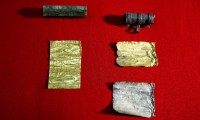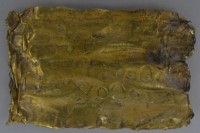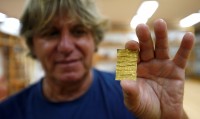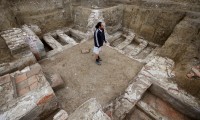 Extremely rare curse tablets made of gold and silver instead of the usual lead have been unearthed at the ancient site of Viminacium in Serbia, about 60 miles east of Belgrade. Archaeologists were excavating land adjacent to power plant before construction of an addition to the plant when they found a large family tomb decorated with colorful wall paintings. There were multiple rooms containing multiple burials from the middle of the 3rd century A.D. through the 5th.
Extremely rare curse tablets made of gold and silver instead of the usual lead have been unearthed at the ancient site of Viminacium in Serbia, about 60 miles east of Belgrade. Archaeologists were excavating land adjacent to power plant before construction of an addition to the plant when they found a large family tomb decorated with colorful wall paintings. There were multiple rooms containing multiple burials from the middle of the 3rd century A.D. through the 5th.
Buried with one of the skeletons dating to the 4th century were two small lead cylinders holding three rolled up sheets, one of silver, two of gold. The silver and gold sheets had writing and symbols inscribed on them. One of them has Greek letters but is written in Aramaic, not Greek. Archaeologists have identified an intriguing combination of names on it: Baal, Yahweh, and Thobarabau, Seneseilam and Sesengenfaranges, three deities/demons (depending on whether your perspective is polytheistic or Christian) native to what is now Syria. A curse tablet inviking the powers of both Baal and Yahweh is unprecedented.
 The other two aren’t inscribed with letters at all, but unknown symbols. Traditionally curse tablets (defixiones in Latin) were written in Greek or Latin with some ununderstandable words. These were voces mysticae, belonging to no known human language, meant to appeal to the deities and demons in words only they could understand. They also used charakteres, symbols believed to represent astrological signs or cosmic forces, or, in the case of Christian curses, angels and other heavenly host. The silver curse tablet is the only one ever discovered written solely in symbols.
The other two aren’t inscribed with letters at all, but unknown symbols. Traditionally curse tablets (defixiones in Latin) were written in Greek or Latin with some ununderstandable words. These were voces mysticae, belonging to no known human language, meant to appeal to the deities and demons in words only they could understand. They also used charakteres, symbols believed to represent astrological signs or cosmic forces, or, in the case of Christian curses, angels and other heavenly host. The silver curse tablet is the only one ever discovered written solely in symbols.
Found throughout the Greco-Roman world even well into the Christian era, curse tablets called on spirits, demonic or divine powers to control a target — destroy an enemy, force restitution of stolen goods, get someone in the sack or make the opposing team lose. The tablets were thin sheets of lead on which invocations against the targets were scratched. They would then be rolled or folded up and placed in a relevant area usually below the ground, graves, wells, temples, sanctuaries or the homes of the cursed.
 The earliest known extant curse tablets were found in the Greek colony of Selinunte in Sicily (modern-day Castelvetrano where they grow the greatest bright green olives) and date to the early 5th century B.C. The 22 Selinute tablets were mostly litigation curses intended to kneecap opponents in a lawsuit. Other popular types of curses include ones against rival sports teams, rival businesses, thieves and love or sex spells. Men tended to deploy curse tablets to arouse women’s passion, while women mostly used curses to stimulate men’s affection.
The earliest known extant curse tablets were found in the Greek colony of Selinunte in Sicily (modern-day Castelvetrano where they grow the greatest bright green olives) and date to the early 5th century B.C. The 22 Selinute tablets were mostly litigation curses intended to kneecap opponents in a lawsuit. Other popular types of curses include ones against rival sports teams, rival businesses, thieves and love or sex spells. Men tended to deploy curse tablets to arouse women’s passion, while women mostly used curses to stimulate men’s affection.
About 1,500 ancient curse tablets have been found. The vast majority are made of lead, some of lead mixed with tin and copper. A tiny fraction are inscribed on precious metals. These are the first curse tablets ever discovered in Serbia. It’s a testament to the wealth of Viminacium that the only defixionis ever found there are extremely rare examples in gold and silver.
 Viminacium was the capital of the Roman province of Moesia Superior. Its strategic position near the border with the Goths made it one of the most important cities in the empire. It had a permanent military camp and was a prosperous trade center. Excavations since its rediscovery in the late 19th century have unearthed the largest Roman amphitheater in the Balkans, 40,000 artifacts, 700 of them gold and silver, and more than 14,000 Roman-era graves (the largest Roman cemetery ever discovered), some of which contained extremely fine and rare jewels, one of which contained unique gold and silver curse tablets.
Viminacium was the capital of the Roman province of Moesia Superior. Its strategic position near the border with the Goths made it one of the most important cities in the empire. It had a permanent military camp and was a prosperous trade center. Excavations since its rediscovery in the late 19th century have unearthed the largest Roman amphitheater in the Balkans, 40,000 artifacts, 700 of them gold and silver, and more than 14,000 Roman-era graves (the largest Roman cemetery ever discovered), some of which contained extremely fine and rare jewels, one of which contained unique gold and silver curse tablets.
The section of the cemetery in which the tablets were unearthed is also home to a number of Christian graves, and archaeologists don’t rule out that some of the dead in the tomb may have been Christian. Orthodoxy wasn’t cemented in the 4th century and the syncretism evinced in the tablet could be the work of a Christian drawing in influences from adjacent, albeit seemingly conflicting, beliefs.
Mainly Catholic (I presume) votive tablets can indeed be found in the Christian era. For instance in Germany, Austria or Italy.
Another interesting article, and if I may add, of much higher quality than the Guardian article on the same subject.
As a matter of fact, I just happen to be working my way through the “Arcana Mundi” by Georg Luck, which is a book on magic and the occult in the Ancient Greek and Roman worlds. Anyone interested in the subject may wish to check out: “Magic and Ritual in the Ancient World” which is a collection of serious scholarly essays on the subject. You can find the book on Academia.edu by doing a search for Roy Kotansky.
Brilliant ! Thanks for sharing this most interesting discovery. Also thanks for the information from the above comment about the book on Magic.
Strong magic associated with sex saturated the European cultures of the ancient world. When Saint Patrick converted to Christianity, and was filled with the Holy Spirit, his ministry in spiritual warfare was powerful against the pagan activities.
So would the inhabitant of the grave be the target of the curse (in the afterlife, of course)? Or were they just a vehicle to get the curse in the ground near the target(s)? (This sounds most likely from the information here.) Oooh, or maybe the deceased left instructions for this to be done to curse someone that they wanted harmed? Fascinating, regardless!
I found it fascinating that the curses were on the subjects held most dear to humans today…sports, power/money (business rivals), and most of all sex/love. Then, there was the antagonism towards rivals in litigation! Nothing ever changes, does it?!
As always, this is a very interesting and informative article. Thanks for all of these.
Cerelle, it still exists. When I was a young man I was often told never to date a woman from Louisiana as they would “work a root on you” if you crossed them, ie; curse you. I once saw a truck driver in Texas refuse to get in his cab due to someone laying down a circle of corn starch around the thing. Most of it is related to Hoodoo and Voudoun practices here in the States.
With the numbers of sports stars from the Caribbean or of Caribbean descent playing in the US, the occasional attempted curse in that field isn’t out of the realm of possibility. Many of them grew up in the milieu of syncretic Afro-Caribbean religions in the region and still practice their faiths. As superstitious and obsessive as many athletes are in general, regardless of background, the idea of someone cursing them would mess with them to no end.
Every casual American baseball fan knows the story of the “Curse of The Goat”. It’s a tale too long and odd to get into here.
Was the belief that a curse written on a gold tablet was more powerful than a silver of lead curse?
And the Castelvetrano olives I need to try. Made me wonder if you had ever done a post on the history of olive cultivation? The wikipedia entry is not clear, but that is due to conflictimg theories I suppose.
Very interesting, Bruce..remind me to stay out of Louisiana..but not much chance of my going there as I hate humidity being from the AZ desert, and anyway mosquitoes like me too much. Amazing in our day of so much known science that these things still prevail.
I need to make one when I croak. Curse of a thousand itches in places they can’t scratch. :skull: